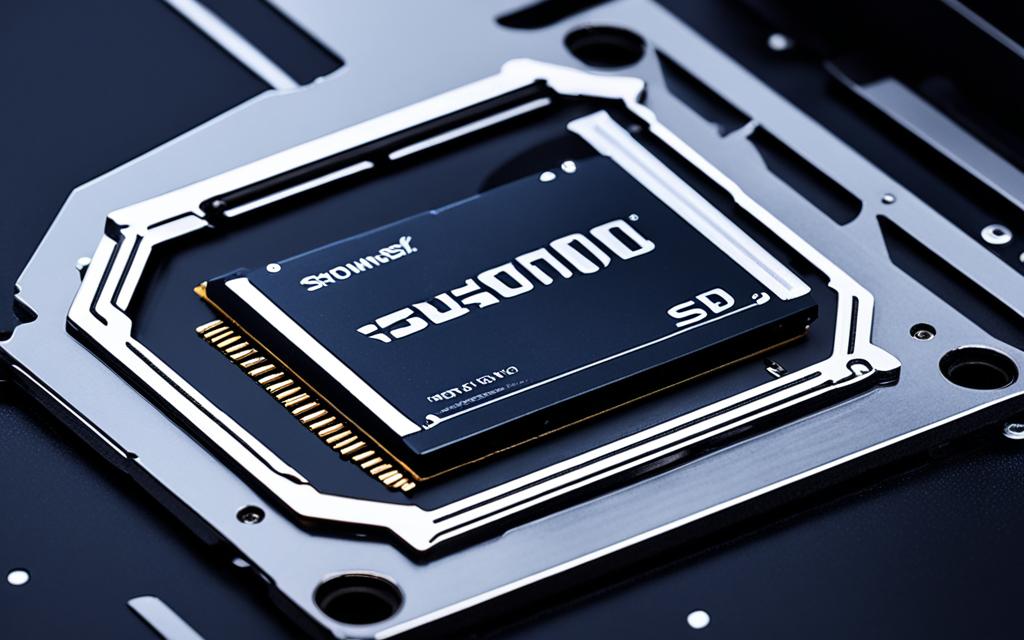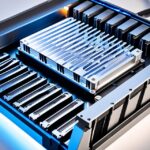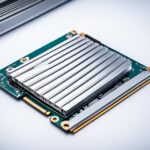Table of Contents
The speed of your solid-state drive (SSD) is key, especially when it gets hot during heavy use. Knowing how to add a heatsink to your SSD is important for top SSD cooling results. A heatsink moves heat away, boosts performance, and stops your SSD from getting too hot. This keeps your SSD running fast1.
Putting a heatsink on your SSD makes it last longer and work better. This is especially true for activities that need a lot of resources, like gaming or video editing. As technology advances, the importance of using such cooling methods becomes clearer. It shows how crucial benefits of SSD heatsinks are in today’s digital age.
Key Takeaways
- Adding a heatsink improves the thermal management of your SSD.
- Proper installation is crucial for maintaining optimal performance.
- M.2 SSDs do not require additional power or data cables.
- Regularly monitoring your SSD’s temperature can prevent performance degradation.
- Using thermal pads enhances the effectiveness of the heatsink.
Understanding the Importance of SSD Cooling
In the high-speed computing world, SSD temperature control is vital. The need for fast data access makes SSDs generate more heat. This is true for NVMe and PCIe Gen4 technologies, which push SSD temperatures up due to fast data speeds. When temperatures get too high, SSD performance drops, leading to thermal throttling. This process slows down speeds to protect the SSD’s inner parts2.
Gaming and video editing benefit from SSDs with heatsinks. Heatsinks help manage heat, keeping data transfer rates stable. Sony says adding a heatsink is key when upgrading PS5 storage for top performance3. The WD_BLACK team at Western Digital also highlights the importance of heatsinks. They show that cooling solutions maintain SSD performance. Heatsinks usually are made from aluminium. This metal is chosen for its ability to conduct heat well and its design that aids SSD heat dissipation.
SSDs can work without heatsinks, but for heavy tasks, having one is better. Some designs integrate the SSD with the heatsink for better performance. This means heat is not just managed; it’s optimally dissipated. This lets the SSD run well for longer without slowing down23. Effective cooling is crucial as computing evolves. It ensures our technology remains fast and reliable.
Benefits of Using a Heatsink on your SSD
Today, SSD heatsinks are seen as more vital in data storage. With NVMe SSDs taking over from traditional 2.5-inch ones, controlling heat is critical. M.2 SSDs can hit temperatures above 80°C when worked hard. This is much hotter than their best operating range of 30°C to 65°C. Overheating can mean slower performance, data loss, or even corrupted files4. A heatsink boosts performance and makes your SSD more reliable.
Despite most motherboards having an M.2 cooler, they’re not always effective. They might lack enough metal or surface area to cool properly. This makes adding a specialised heatsink essential, particularly for SSDs without one built-in. Affordable choices like those from Micro Connectors, Sabrent Rocket, or Jonsbo make a big difference4.
Using thermal pads or copper sheets helps pull heat away from the controller. This keeps it cool while letting the flash chips warm up as needed. It’s a balance to stop throttling and keep your SSD running well. So, using a NVMe heatsink is advised for many SSDs, helping them last longer5.
| Feature | With Heatsink | Without Heatsink |
|---|---|---|
| Temperature under load | 70°C or lower | Above 80°C |
| Data transfer speeds | Consistent performance | Throttling likely |
| Risk of data loss | Minimised | Increased |
| Controller efficiency | Optimised cooling | Vulnerable to overheating |
Choosing the Right Heatsink for Your SSD
Choosing the right heatsink for your SSD is key to keeping it running smoothly and lasting longer. You need to make sure the heatsink fits by looking at the SSD’s details. Heatsinks come in different styles, like passive or active, which change how well they cool.
Heatsinks are made from materials such as aluminium and nickel-plated copper. These are chosen for their good heat moving abilities. For SSDs like the Crucial T700, these materials work well because they get rid of heat quietly6.
To stop your SSD from slowing down due to heat, a heatsink is important. This is especially true for the faster PCIe 4.0 and 5.0 NVMe drives. They need strong cooling to keep up their speed when moving a lot of data7. Make sure the heatsink you choose can handle the heat your SSD makes. Bigger heatsinks are usually better at cooling8.
For gamers or people who do 3D rendering, a good heatsink can improve your SSD’s performance. It keeps the SSD within the safe temperature zone of 0 to 70 °C (32 to 158 °F)6. If your SSD gets hotter than 65°C (149°F), think about getting more cooling to help it last longer8.
Always look at what the SSD maker says about heatsinks. You want to make sure the heatsink works well with your motherboard. Remember, some motherboards already have cooling built in7.
| Heatsink Type | Material | Pros | Cons |
|---|---|---|---|
| Passive | Aluminium | Lower cost, no noise | Less effective in high load situations |
| Active | Nickel-Plated Copper | Better cooling performance | Noise and potential failure risks |
| Integrated | Varies | Space-saving, convenient | Limited to motherboard specifications |
Preparing Your SSD for Heatsink Installation
It’s important to prepare your SSD well for heatsink installation. Start by cleaning your SSD well. This gets rid of dust or debris that might block the thermal pad. A clean SSD means better heat transfer and more efficient running.
After cleaning, check if there’s a protective film on the thermal pads. You need to remove this film before moving on. It can stop the heatsink from working well. Knowledge of these steps is crucial, as mentioned in this installation guide.
Next, get the tools you need, like tweezers, for handling small parts. This helps make sure the SSD fits right in its slot. Correct fitting improves its work life and performance.
If you skip these steps, you might face performance issues or even harm your SSD. So, pay close attention to these preparation tips. They’ll help get the best thermal performance from your heatsink. That way, your SSD can perform at its best9.
| Step | Action |
|---|---|
| 1 | Clean the SSD thoroughly to ensure optimal contact. |
| 2 | Check for and remove any protective films on thermal pads. |
| 3 | Gather necessary tools such as tweezers. |
| 4 | Ensure proper seating of the SSD in its slot. |
Getting your SSD ready the right way is key. Not only does it improve performance, but it also makes your SSD last longer. Good preparation means your SSD will keep working well, even in fast operations. This ensures top-notch performance throughout its life10.
How to Add a Heatsink to Your SSD
Putting a heatsink on your SSD is key to keeping it running well. This guide tells you how to add a heatsink the right way. Find the tools you need, take off protective films, and line up the heatsink perfectly.
Gathering the Necessary Tools
First, make sure you’ve got all the right tools for the job. You’re going to need:
- Philips screwdriver
- Tweezers for handling thermal pads
- Isopropyl alcohol for cleaning surfaces
- Soft cloth to wipe the SSD
- Thermal paste, if it’s needed
Removing Protective Films from Thermal Pads
Got your tools? Now, take the protective films off the thermal pads on the heatsink. Use tweezers so you don’t touch them. This keeps the pads clean and effective. Do this carefully to avoid any damage.
Aligning and Securing the Heatsink
Now, it’s time to put the heatsink on. Good alignment means no blocked connectors on the SSD. Place the heatsink carefully, making sure it’s in the middle. Press down lightly once it’s aligned.
Secure it as the maker says. A tight fit is important for good heat control when in use.
Installing a heatsink like this helps your SSD work better and last longer. It keeps the heat down. We’ve gone through each step to keep you from making mistakes. Now, you should have a smooth installation.
With a score of 4.6 out of 5 from 3,852 reviews, the need for good installation is clear11.
Managing heat well is crucial for top performance, especially for M.2 SSDs that can hit speeds of 5,500MB/s or more12.
Installing Your M.2 SSD with the Heatsight
When you install your M.2 SSD with a heatsink, it’s key for the best performance and long life. It’s vital to know about M.2 slots and how they fit with your SSD. Different motherboards support various M.2 setups, which could cause issues if not checked. Make sure to look at the manufacturer’s guide to ensure your drive is compatible.
Understanding the M.2 Slot and Compatibility
The M.2 slot fits several SSD sizes, from 2230 to 2280. Every size needs specific checks to ensure your SSD and motherboard match. For PlayStation 5 users wanting more storage, M.2 SSDs need to meet certain criteria. They require a PCI-Express Gen4x4 interface and a read speed of at least 5,500MB/s12. You can choose from 250 GB to 8 TB of space, so there’s plenty of room for your games without losing speed12.
Securing the SSD in Place
After ensuring everything matches, start installing your M.2 SSD. Insert the SSD carefully into its slot, making sure it fits right. Next, you’ll need to fix it in place with screws or a latch. This is important to keep your SSD stable and performing well. Also, remember that how well you secure the SSD affects how effectively it uses the heatsink to stay cool.
Always follow the safety steps like not turning on your device when it’s open, as the installation guide suggests. By following these instructions, you’ll have a sturdy and safe storage upgrade. This reduces the chance of damage from heat or a bad install13.
Testing Temperature and Performance After Installation
After installing a heatsink on your SSD, it’s important to test its performance. Begin by monitoring the SSD’s temperature using software. Check the temperature during rest and when it’s busy. This can be done by looking at temperature monitoring sites.
Stress tests or usual tasks help see if the heatsink works well. For instance, a Gen4x4 SSD can hit 70 degrees Celsius quickly if it’s not using a heatsink. However, with a heatsink, it stays cooler when it’s working hard14. This shows how vital cooling is for maintaining performance.
Comparing data from before and after installing the heatsink is key. This comparison shows how well the heatsink handles heat problems that NVMe SSDs often have. Especially in fast environments where heat can go up quickly14. Studies have proven that passive heatsinks keep read and write speeds stable. They also help the SSD last longer and keep data safe14.
Simulation data can also show how much a heatsink boosts performance. Don’t forget the steps needed after installing it, as they confirm your cooling solution’s benefits. Keeping an eye on the system will spot any thermal issues early. This ensures your SSD performs well for a long time.
Conclusion
Choosing a heatsink for your SSD is a smart move. It boosts both performance and lifespan. By keeping your system cool, you avoid slowdowns due to overheating. Regular care of your SSD, with a heatsink, is key to keeping it working well for longer. This ensures your SSD will perform well in the future.
For NVMe SSDs that range from 250GB to 4TB, picking the right heatsink is crucial. It’s not just an extra piece but an investment in your device’s long-term health. High-quality options like the INEO/Graugear PS5 Heatsink are available, but they might cost more, usually between $10-1515. Yet, understanding the value of a good heatsink can help you make smarter choices that benefit your computer or gaming setup.
Keeping your SSD and its technology up-to-date is important. Whether it’s a cheap or a more expensive heatsink, regular maintenance is key to a durable system1617. In the end, the right cooling solutions for your SSD do more than just boost performance. They also help your system meet future demands.
FAQ
What is the purpose of adding a heatsink to my SSD?
Heatsinks on SSDs boost cooling, keeping temperatures down. This stops performance drops due to high heat during heavy use.
How does SSD cooling affect performance?
Cooling your SSD helps keep data moving quickly and your system stable. Cold SSDs work faster and last longer.
What are the benefits of using a heatsink on my SSD?
Heatsinks make your SSD run better, cut overheating risks, and keep it working longer. They’re great for SSDs that get very hot.
How do I choose the right heatsink for my SSD?
Look at M.2 compatibility, materials like copper or aluminium, and size for cooling. Make sure it fits your SSD by checking its specs.
What preparation is needed before installing a heatsink?
Clean your SSD and make sure thermal pads touch well. Remove all films on the pads and check the SSD fits right in its place.
What tools are necessary for installing a heatsink?
You’ll need tweezers for thermal pads, something to clean with, and a screwdriver for the SSD. These help you install smoothly.
How do I install a heatsink on my SSD?
Start by getting your tools ready. Remove film from thermal pads, then align and fix the heatsink on the SSD without covering connectors.
How can I ensure the M.2 SSD is installed properly with the heatsink?
Make sure the M.2 slot works with your motherboard. Carefully put in the SSD, match notches, and secure it, following the guide.
How do I test the temperature and performance of my SSD after installation?
Check the SSD’s temperature with monitoring tools. Use stress tests to see if the heatsink keeps it cool under load.
Why is regular maintenance important for my SSD?
Maintenance keeps your SSD working well, longer. Upgrade cooling as needed, especially for heavy use tasks.
Source Links
- https://www.pcgamesn.com/how-to-install-ssd – How to install an M.2 SSD
- https://blog.westerndigital.com/ssd-heatsink-hot-storage-cool-data-m2/ – SSD Heatsink: Hot Data, Cool Storage
- https://www.kingston.com/en/blog/gaming/playstation-5-heatsink-ssd-explained – PlayStation 5 and Heatsink SSDs Explained
- https://www.easeus.com/computer-instruction/do-i-need-a-heatsink-for-my-m2-ssd.html – Do I Need a Heatsink for My M.2 SSD [2024 Full Guide]
- https://community.frame.work/t/are-ssd-heatsinks-worth-it-or-a-waste/27525 – Are SSD Heatsinks worth it or a waste?
- https://www.crucial.com/articles/about-ssd/do-you-need-an-nvme-ssd-heatsink – Do you need an NVMe SSD heatsink?
- https://forum.level1techs.com/t/are-nvme-heatsinks-worth-it-990-pro/202418 – Are NVMe Heatsinks Worth It? (990 Pro)
- https://www.taidahardware.com/blogs/choosing-the-right-ssd-heatsink-key-factors-for-it-professionals – Choosing the Right SSD Heatsink: Key Factors for IT Professionals
- https://www.crucial.com/content/dam/crucial/ssd-products/t500/install-guide/crucial-pcie-nvme-ssd-with-heatsink-install-guide.pdf – Crucial NVMe SSD with Heatsink Install Guide (EN)
- https://www.aok-technologies.com/news/How-to-Install-a-Thermal-Pads-on-an-M.2-SSD.html – How to Install a Thermal Pads on an M.2 SSD? | SSD Thermal Pad
- https://www.amazon.co.uk/QIVYNSRY-heatsink-Double-Sided-Thermal-Silicone/dp/B08QCTR12L – QIVYNSRY M.2 Heatsink NVME 2280 SSD Heat Sink Support Single Double Sided M2 SSD Cooling with Thermal Silicone Pads Cooler for Computer PC PS5 PCIE NVME or NGFF SATA M.2 SSD Installation, Black : Amazon.co.uk: Computers & Accessories
- https://www.playstation.com/en-us/support/hardware/ps5-install-m2-ssd/ – How to add an M.2 SSD to a PS5 console (US)
- https://rog-forum.asus.com/t5/intel-500-400-series/how-to-install-nvme-ssd-with-own-heatsink-on-an-apex-xiii/td-p/904417 – How to install NVME SSD with own heatsink on an Apex XIII mainboard?
- https://www.techtarget.com/searchstorage/post/Understand-SSD-overheating-and-what-to-do-about-it – Understand SSD overheating and what to do about it | TechTarget
- https://nascompares.com/review/ineo-graugear-ps5-ssd-m13-heat-pipe-heatsink-review-temperature-testing/ – INEO / Graugear PS5 SSD M13 Heat Pipe Heatsink Review & Temperature Testing
- https://www.tomshardware.com/features/ps5-ssd-upgrade-temperature-testing – PS5 SSD Upgrade Temperature Testing: Do You Even Need a Heatsink?
- https://www.amazon.co.uk/ORICO-M-2-SSD-Heatsink/dp/B0CYL2PSXM – ORICO M.2 SSD Heatsink, Copper Fin M.2 Cooler with Thermal Pad Thermal Conduction+Aluminium Cooling for Single and Double Sided 2280 NVME/NGFF M.2 SSD and PS5, Gold-M2HS1 : Amazon.co.uk: Computers & Accessories












